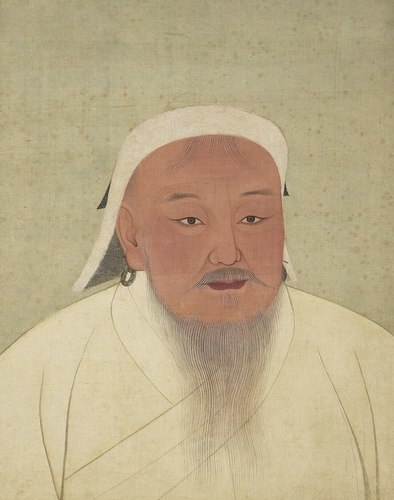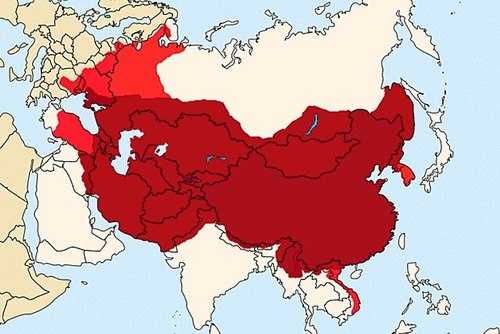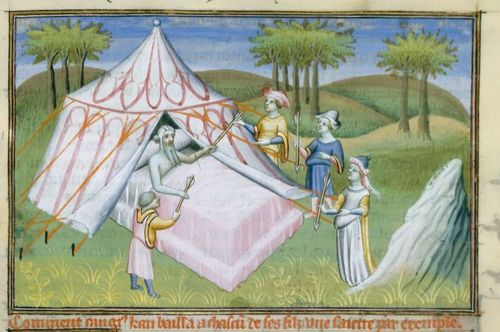Noiser
Genghis Khan: Five Facts About the Mongol Leader
Play Short History Of... The Gladiators
Genghis Khan built one of the largest empires the world has ever known through cunning, brutality, and revolutionary military tactics. Here are five facts that reveal the man behind the legend.

1. He killed his own brother.
Temujin, who would later rise to fame as Genghis Khan, was born in 1162 near the border of Mongolia and Siberia. His early life was marked by a series of hardships that few experience in a lifetime, let alone before reaching adulthood. The region he lived in was treacherous, with rival nomadic tribes constantly battling for dominance. Before he turned ten, his father was poisoned. Following this, Temujin’s own tribe abandoned his family, unwilling to share their resources with him, his mother, and his six siblings. Facing starvation, Temujin killed his half-brother in a power struggle and assumed responsibility as head of the family. His trials didn't end there. At one point, he was captured and enslaved by the very clan that had rejected him, but he was eventually able to escape.
2. He wasn’t afraid of going against ancient customs.

In many Mongol tribes, it was customary to appoint relatives to key positions, regardless of how well-suited to the job they were. However, as Temujin rose to power, he broke away from this tradition, favouring merit over bloodline. Initially, it was an unpopular decision but highly effective in the long run.
He also changed traditional warfare tactics. Rather than annihilating enemy tribes entirely (as was the custom), Temujin employed a strategic approach. He executed their leaders but integrated the remaining men into his own army, swelling its ranks.
Though known for his brutality in warfare, Temujin’s rule was progressive in some ways. He fostered religious tolerance within his empire, allowing his subjects to practice their faiths freely, whether they were Muslim, Christian, Buddhist, or animist (the belief that objects, places, and creatures all possess a distinct spiritual essence). His emphasis on inclusivity helped solidify his control over the vast and diverse territories he conquered.
3. His achievements earned him a new name.

Through a combination of outstanding military tactics and merciless brutality, Temujin swept across the continent, wiping out tribes and claiming vast territories. By 1206, Temujin had defeated the powerful Naiman tribe, who ruled over parts of Western Mongolia and modern-day Kazakhstan, uniting the Mongol tribes under his leadership.
Temujin was not only a formidable warrior but also an excellent tactician. He embraced the use of spies, devised coordinated attacks, and ensured his soldiers were well-prepared, carrying not only weapons but also spare food and clothing for long campaigns. In addition to this, he often used psychological warfare to intimidate his enemies. Sometimes, he would intentionally let survivors escape during attacks to spread terrifying stories of Mongol savagery. This caused many cities and tribes to surrender without a fight.
In recognition of his unparalleled battlefield prowess, Temujin was given the honorific title "Chinggis Khan", which roughly translates to "Universal Ruler." Genghis Khan is a Westernised version of the same name. Through a combination of outstanding military tactics and merciless brutality, Temujin swept across the continent, wiping out tribes and claiming vast territories. By 1206, Temujin had defeated the powerful Naiman tribe, who ruled over parts of Western Mongolia and modern-day Kazakhstan, uniting the Mongol tribes under his leadership.
Temujin was not only a formidable warrior but also an excellent tactician. He embraced the use of spies, devised coordinated attacks, and ensured his soldiers were well-prepared, carrying not only weapons but also spare food and clothing for long campaigns. In addition to this, he often used psychological warfare to intimidate his enemies. Sometimes, he would intentionally let survivors escape during attacks to spread terrifying stories of Mongol savagery. This caused many cities and tribes to surrender without a fight. In recognition of his unparalleled battlefield prowess, Temujin was given the honorific title "Chinggis Khan", which roughly translates to "Universal Ruler". Genghis Khan is a Westernised version of the same name.
4. The empire he built was bigger than Rome.
Genghis Khan's empire became the largest contiguous land empire ever, stretching from the Pacific Ocean to Eastern Europe. At its height, the Mongol Empire encompassed much of present-day Russia, the Middle East, and Central Asia.
 One of Genghis Khan's last campaigns took place in 1227 in what is now known as China. There, the Tanguts of Xi Xia had defied his orders and were in open revolt. His revenge was swift as he and his army rode through their lands, sacking towns and claiming decisive victories. To solidify his dominance and eliminate any future threats, Genghis Khan ordered the execution of the entire imperial family, effectively erasing the Tangut lineage and stamping out their resistance permanently.
One of Genghis Khan's last campaigns took place in 1227 in what is now known as China. There, the Tanguts of Xi Xia had defied his orders and were in open revolt. His revenge was swift as he and his army rode through their lands, sacking towns and claiming decisive victories. To solidify his dominance and eliminate any future threats, Genghis Khan ordered the execution of the entire imperial family, effectively erasing the Tangut lineage and stamping out their resistance permanently.
5. His cause of death remains a mystery.

Genghis Khan died in August 1227 at the age of 65. However, the exact circumstances of his death remain a mystery. The most widely accepted theory is that he was thrown from his horse, sustaining severe internal injuries from which he never recovered. Some scholars suggest that he may have contracted malaria or bubonic plague, while others believe that an arrow wound to the knee led to a fatal infection.
Regardless of how he died, Genghis Khan left an indelible mark on history. He revolutionised warfare, ruled over one of the largest empires the world has ever known, and is believed to have left an army of descendants. Genetic studies suggest that millions of men in Central Asia and beyond carry a Y-chromosome lineage linked to Genghis Khan. This genetic marker is present in approximately 1 in 200 men worldwide, meaning around 0.5% of the global male population today can trace their ancestry back to the Mongol ruler.